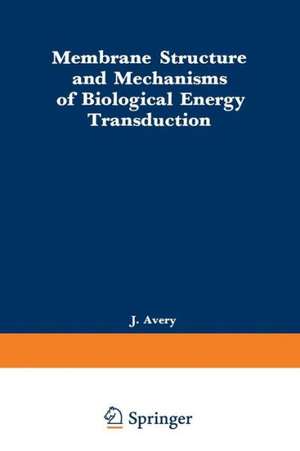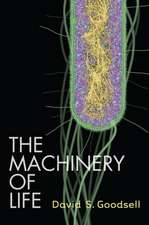Membrane Structure and Mechanisms of Biological Energy Transduction
Editat de J. Averyen Limba Engleză Paperback – 17 mar 2012
Preț: 405.06 lei
Nou
Puncte Express: 608
Preț estimativ în valută:
77.51€ • 82.88$ • 64.62£
77.51€ • 82.88$ • 64.62£
Carte tipărită la comandă
Livrare economică 17 aprilie-01 mai
Preluare comenzi: 021 569.72.76
Specificații
ISBN-13: 9781468420180
ISBN-10: 1468420186
Pagini: 620
Ilustrații: X, 602 p.
Dimensiuni: 152 x 229 x 33 mm
Greutate: 0.82 kg
Ediția:1973
Editura: Springer Us
Colecția Springer
Locul publicării:New York, NY, United States
ISBN-10: 1468420186
Pagini: 620
Ilustrații: X, 602 p.
Dimensiuni: 152 x 229 x 33 mm
Greutate: 0.82 kg
Ediția:1973
Editura: Springer Us
Colecția Springer
Locul publicării:New York, NY, United States
Public țintă
ResearchCuprins
A: Mechanisms of Biological Energy Transduction.- The Development of Bioenergetics.- Chemiosmotic Coupling in Energy Transduction: A Logical Development of Biochemical Knowledge.- Solution of the Problem of Energy Coupling in Terms of Chemiosmotic Theory.- A Model of Membrane Biogenesis.- Energy Transduction in the Functional Membrane of Photosynthesis: Results by Pulse Spectroscopic Methods.- Toward a Theory of Muscle Contraction.- Bioenergetics of Nerve Excitation.- An Analytical Appraisal of Energy Transduction Mechanisms.- Oxidative Phosphorylation, A History of Unsuccessful Attempts: Is It Only An Experimental Problem?.- On the Coupling of Electron Transport to Phosphorylation.- Functional Organization of Intramembrane Particles of Mitochondrial Inner Membranes.- On Energy Conservation and Transfer in Mitochondria.- An Enzymological Approach to Mitochondrial Energy Transduction.- ATP Synthesis in Oxidative Phosphorylation: A Direct-Union Stereochemical Reaction Mechanism.- The Electromechanochemical Model of Mitochondrial Structure and Function.- B: Membrane Structure.- The Relationship of the (Na+ + K+)-Activated Enzyme System to Transport of Sodium and Potassium Across the Cell Membrane.- On the Meaning of Effects of Substrate Structure on Biological Transport.- Performance and Conservation of Osmotic Work by Proton-Coupled Solute Porter Systems.- Molecular Basis for the Action of Macrocyclic Carriers on Passive Ionic Translocation Across Lipid Bilayer Membranes.- Mechanisms of Energy Conservation in the Mitochondrial Membrane.- Biogenesis of Mitochondria 23. The Biochemical and Genetic Characteristics of Two Different Oligomycin Resistant Mutants of Saccharomyces Cerevisiae Under the Influence of Cytoplasmic Genetic Modification.- A Physio-chemical Basis for Anion, Cation and Proton Distributions between Rat-liver Mitochondria and the Suspending Medium.- Microwave Hall Mobility Measurements on Heavy Beef Heart Mitochondria.- Possible Mechanisms for the Linkage of Membrane Potentials to Metabolism by Electrogenic Transport Processes with Special Reference to Ascaris Muscle.- The Effect of Redox Potential on the Coupling Between Rapid Hydrogen-Ion Binding and Electron Transport in Chromatophores from Rhodopseudomonas Spheroides.- A Note on Some Old and Some Possible New Redox Indicators.- The Role of Lipid-Linked Activated Sugars in Glycosylation Reactions.- Lipid-Protein Interactions in the Structure of Biological Membranes.- Structure-Function Unitization Model of Biological Membranes.- The Influence of Temperature-Induced Phase Changes on the Kinetics of Respiratory and Other Membrane-Associated Enzyme Systems.- Interactions at the Surface of Plant Cell Protoplasts; An Electrophoretic and Freeze-etch Study.







